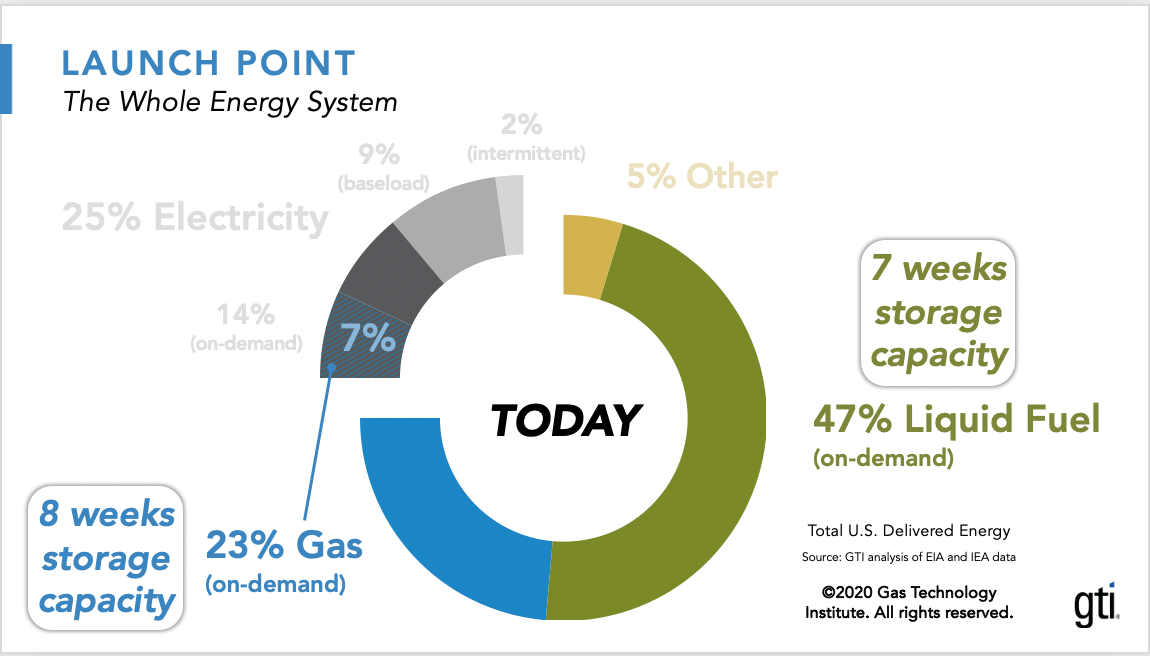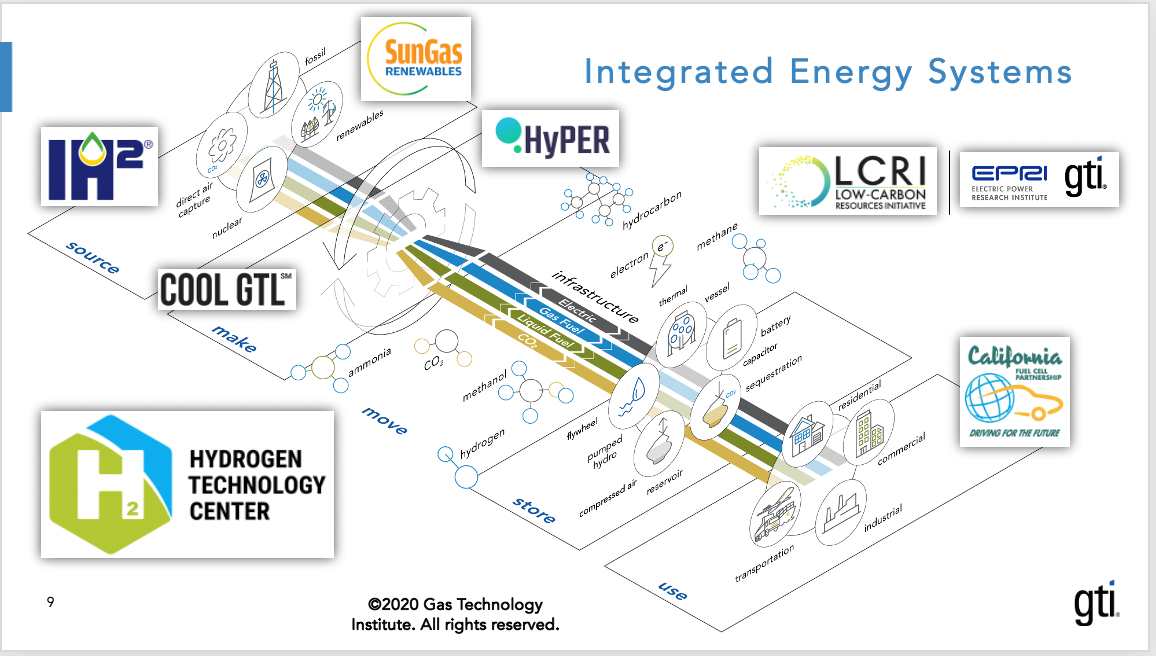By Dr. Derek Wissmiller, R&D Engineering Manager, GTI
August 27, 2020
Today I had the opportunity to participate in the Energy Storage Association’s #ESACon20. Joined by Jeff St. John, Dr. Laura Nelson, and Ashkan Nassiri , I laid out my case for how GTI and the broader gases and fuels communities can partner with the energy storage community to create low-cost, low-carbon energy systems in 2030 and beyond.
So often, we talk about energy in different silos—how will we decarbonize transportation? Our power supply? Industrial processes? GTI understands that energy systems are increasingly integrated, so applying systems thinking is critical to solving these economy-wide decarbonization questions—including grid-scale storage solutions.
Our inquiry is driven by two imperatives: to decarbonize energy systems and to supply energy needed for economic growth. To drive clean energy transitions for both developed and developing economies, we must continue to deliver energy that is affordable, accessible, safe, and reliable. GTI envisions a carbon-managed future in which integrated energy systems leverage low-carbon or carbon-neutral fuels, gases, and infrastructure.
THE WHOLE ENERGY SYSTEM
To tackle these dual imperatives, we need to think about the whole energy system—how we make and use electrons or fuel molecules AND how we move and store those energy products. Former U.S. Secretary of Energy Moniz said it best: “[Renewables] will be critical components to get electricity to zero carbon. But we need, frankly, an assault across the board on all approaches. So renewables and batteries, yes. But we need storage for longer time periods than a few hours. ... We need to start getting hydrogen really deployed.”
MOLECULES & GASES
Carbon-neutral gases and fuels will continue to play a critical role in energy systems of the future, especially in difficult-to-decarbonize sectors and for storage. Carbon-neutral gases and fuels can provide reliable, grid-scale, long-duration energy storage in a post-2030 world.
INFRASTRUCTURE & STORAGE
Infrastructure is how we get energy where we need it, when we need it. Infrastructure is fundamental to enabling grid-scale energy transport and storage. With 2.6 million miles of gas pipelines in the U.S., today’s infrastructure offers reliable, resilient, long-distance energy transport, direct-to-customer delivery, and vast storage capacity to address seasonal demand variations.
INTEGRATED ENERGY SYSTEMS
The energy systems of both today and tomorrow will contain similar elements but there will be interesting connections between them in the future. For instance, renewable electricity will help produce gases and fuels as a means for grid-scale energy storage.
We need to be thinking about the whole energy system and a whole menu of solutions, in terms of R&D priorities. GTI is actively developing carbon-managed technologies that fit in this future energy landscape. The illustration shows just a sampling of our technologies and initiatives, including efforts to turn biomass into carbon-neutral methane or renewable natural gas and liquid fuels.
TODAY’S ENERGY SYSTEM
To understand how gases and fuels can support our collective energy storage needs, let’s look at the energy system of today. The pie chart represents the energy delivered to end users in the U.S., and what form of energy the customer pays for.

Gases and liquid fuels inherently store energy over long durations, and we can use them on-demand. And, in fact, gas plays a major role in providing on-demand electricity; up to a third of electricity is produced from gas. In today’s energy system, gas-fired power generation plays a vital role in providing reliable on-demand power to balance the electric grid. We expect that to continue well into the future. That’s made even more pronounced when we look at the existing storage capacity for these gases and fuels. Altogether, gases and fuels account for nearly 80% of ALL delivered energy to ALL end-use sectors—and we’ve got enough storage capacity to deliver that level of energy for nearly 2 months.
This is a vast storage capacity—and we need it, both today and in future energy systems to address seasonal demand variations, ensure reliability and resiliency, and dampen energy price volatility. We didn’t build this storage capacity and infrastructure overnight. To decarbonize our economy quickly and cost-effectively, we need to leverage these systems.
THE ENERGY SYSTEMS OF THE FUTURE
We will face new challenges and opportunities with the energy systems of the future. We expect increased energy demand, more renewables online, increased electrification, and the introduction of decarbonized gases and fuels. Leveraging the vast gas and liquid fuel storage that we have will be critical to achieving affordability in transitions to clean energy systems.
To rise to the challenge of economy-wide deep decarbonization post-2030, we need planning, investment, and R&D decisions to consider:
- the whole energy system;
- the vital role that fuels and infrastructure will play; and
- an all-across-the-board approach to energy storage that balances demand and supply to provide reliable, resilient, and affordable energy.
The challenge ahead of us requires collaboration. Only then can we achieve our common goals of deploying cleaner energy systems and the robust energy storage solutions needed to support them.
Learn more about my presentation at ESACON20
Click here to download my full presentation, and feel free to contact me with questions or interest in collaborating.
About GTI
GTI has an extensive 80-year history of developing clean energy technologies. Our portfolio is broad and expanding – including natural gas, hydrogen, biofuels, synthetic fuels, power production, carbon capture, greenhouse gas mitigation, and much more. We have deep technical expertise and experience across the whole energy system – energy supply, conversion, delivery, and end use.
Learn More
Contact the energy experts today

